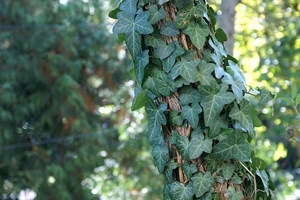Ivy
 “The holly and the ivy, when they are both full grown,
“The holly and the ivy, when they are both full grown,
Of all the trees that are in the wood, the holly bears the crown.”
Holly and ivy has been the mainstay of Christmas decoration for church use since at least the 15th Century, but do you know what butterfly links these two plants together? The holly blue butterfly lays the eggs of its first brood on holly in the spring, but chooses ivy as the food plant for its second brood in the summer, which makes this butterfly unique in the British Isles, as it is the only species that chooses different food plants for its two broods.
The hymn may claim that holly bears the crown, but I want to “blow the trumpet” on behalf of ivy. Whenever this plant comes up in conversation, many people become really quite vicious about it, demanding its mass destruction wherever possible! “It strangles the life out of trees” is a common accusation. Indeed, ivy can smother smaller trees such as hawthorn growing in hedgerows, eventually acting as a bulky leafy sail, which brings the host crashing to the ground during a winter gale. However, most healthy trees can happily tolerate ivy growing up their trunks, as the plant uses pads of rootlets to cling to the surface and is only using the tree as a support – it does not feed off the tree as many believe. Ivy is self-sustaining and only really competes for nutrient and water at the base of the tree – it climbs to gain light and a greater leaf area than it can when growing at ground level.
But is ivy good for anything other than a second brood of holly blue butterflies? Absolutely – it is an important plant in conservation terms. Before leaving butterflies, I have to mention the sulphur yellow brimstone butterfly – often the first butterfly of the year on the wing. First, because it hibernates as an adult – in yes you’ve got it – ivy! (If you look at a brimstone butterfly hanging upside down – it looks just like a dead Ivy leaf!) Many other creatures hibernate, roost and nest in ivy – it provides wonderful cover, when most other leaves have been shed. In many of our under managed woodlands, especially where there are no other evergreens present such as holly, ivy is often the only plant that offers this important protective cover.
The little greenish yellow flowers of ivy are one of the very last nectar sources to be produced in the year, appearing right at the end of summer and lasting into autumn, thus being vital for many species of wasp, bee and flies to gorge on before hibernation. You may well have seen butterflies such as the red admiral nectaring on ivy too. The purple-black berries of ivy do not fully form until the very end of the year at a time when most other berries have long been eaten, providing a vitally important new food source for some of our birds such as blackbirds and thrushes. In fact, it is birds that disperse the little seeds within the berry.
So, think twice before you get your clippers out to hack back the poor old ivy – there is much more to this plant than meets the eye!
Peter Thompson
Advisory

Download Peter Thompson's essential 26-page book, featuring beautiful photography and detailed profiles of Britain's wildlife
Download FREE >